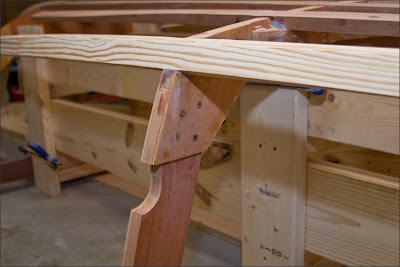I decided to go ahead and rough-fit the forward panel on the starboard side. First, I marked and cut one of the Meranti panels in half lengthwise, giving me two 2' x 8' panels to use for the side planking.
Using one of these panels, I began to fit it to the starboard side. I had to go through several cycles of "Clamp, Mark, Remove, Cut, Repeat" in order to cut away extraneous material from the front of the panel. This was due to the low height of the construction form. For several attempts I could not bend the plywood all the way around to the bow without the floor getting in the way.
Finally, I got it roughly fit & it is now temporarily clamped into position. Once I'm satisfied with the fitting, I will check the starboard panel against the port side. If everything looks like a suitable fit, I will then use this panel as a template to mark and cut the second panel from the other 2' x 8' piece of plywood.
So far, I'm pretty pleased with the Meranti. It is a nicer-looking wood than I expected, and it seems to bend much easier than the Douglas Fir plywood.
 |
| Forward panel rough-fit & clamped into position on the starboard side. |





















































